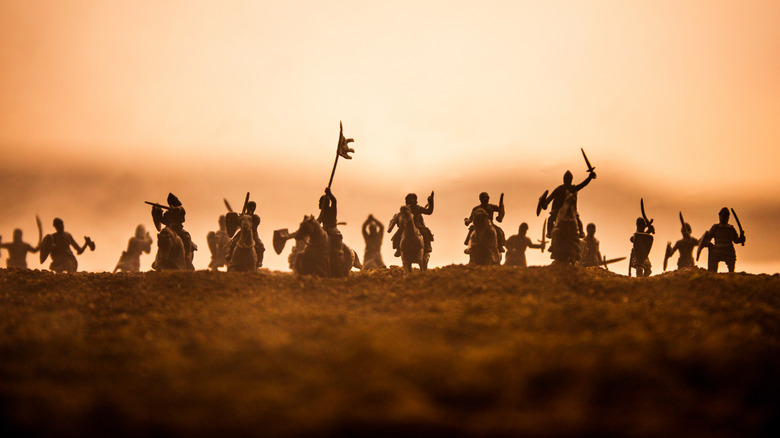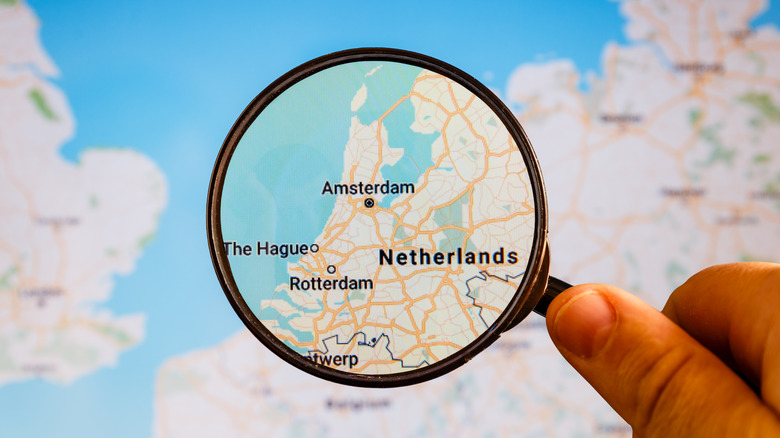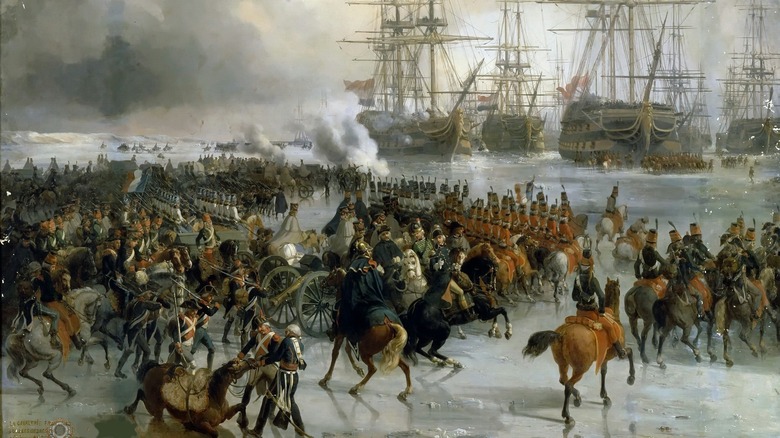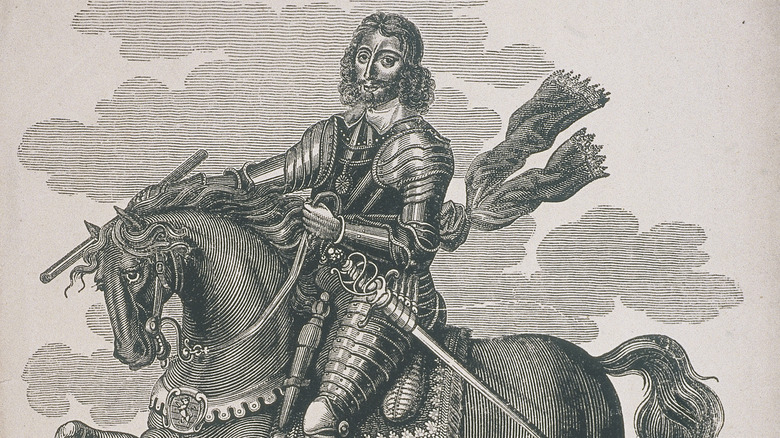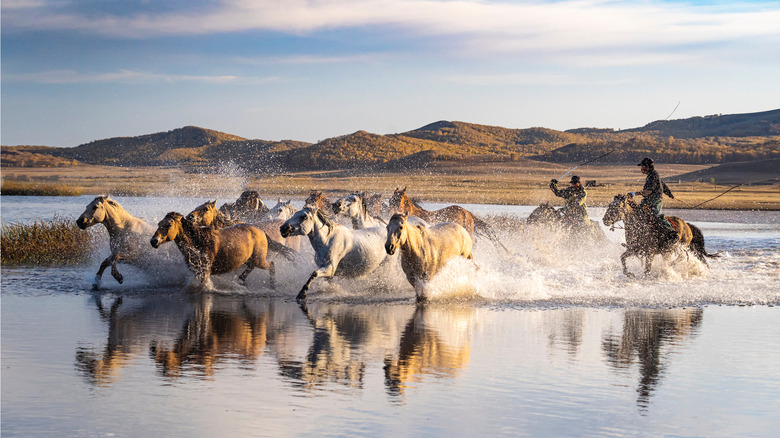The True Story Of How Soldiers On Horseback Outwitted A Fleet Of Ships At Sea
Military history is filled with stories of soldiers, their leaders, and even civilians overcoming long odds and managing to get a victory, however minor, over their adversaries. For example, by some measures, the entire Revolutionary War was an impossible victory for the Americans; "a ragtag volunteer army in need of a shower, defeat[s] a global superpower," as Aaron Burr famously describes it in "Hamilton." Similarly, American seaman Doug Hegdahl was captured by the Vietnamese but pretended to be unable to read or write, convincing his captors that he was useless. Instead, he memorized the names of his fellow POWs, as well as key facts about where they were held, and the information he provided helped the Defense Department assure the soldiers' families that they were alive.
Another such unlikely military victory occurred in 1795, when a Dutch fleet (of ships, it bears noting) was outfoxed by a French brigade on horseback(!). It was one of the only times in military history when a cavalry brigade got the upper hand on a naval force, and it would take the cooperation of the weather and some cool heads at headquarters for the event to go down without any bloodshed.
Setting the Scene
The history of the French Revolutionary Wars (1792-1799) is filled with twists and turns, and it wasn't just the French government and elements within France that were invested in the outcome. Other European powers — in particular the Dutch — had an iron in the fire, so to speak, and of course, there were hired foreign mercenaries whose allegiance could be bought and sold.
By January 1795, the French and the Dutch had made peace, even as French troops occupied the northern reaches of the country. However, some Dutch were still loyal to their stadhouder — a title sort of like "commander" — back home. It was in this context of constantly-shifting loyalties and a political situation that hadn't yet worked itself out that a contingent of Dutch ships arrived in the strait of Marsdiep and tried to shelter by Texel island as a severe storm raged. According to Smithsonian Magazine, when the storm had subsided, the Dutch were iced in (the winter of 1794-1795 was particularly harsh). French general Jean-Charles Pichegru learned of the matter and told his subordinate Johan Williem de Winter, a Dutch admiral who worked for the French, to sort things out. A French cavalry brigade, as well as their Hussar (mercenary) counterparts, turned up.
Ordinarily, a cavalry brigade and a naval fleet wouldn't trade shots with each other. But the ice gave the French easy (-ish) access to the Dutch ships.
What Didn't Happen
Before sorting out what actually happened that week, we need to first put aside what could have happened (but didn't). Writing in his book, "Blunders and Disasters at Sea," excerpted via Smithsonian Magazine, author David Blackmore writes that the stage was set for a prolonged and pitched battle. Though iced in, the Dutch ships had superior firepower and were close enough that they could have covered each other. Further still, the French would have needed heavy firepower, as well as ladders and ropes to climb the vessels. None of that happened.
The Dutch, however, were actually keen to surrender before any shots were even fired. "Seeing [the French and Hussar] campfires, Captain Reyntjes, oldest and most senior officer in the Dutch fleet and in temporary command of it, prepared to spike all guns and scuttle the ships," Blackmore wrote. In other words, they were prepared to disable their own weapons and sink their own ships.
None of that happened, either.
What Actually Happened
A number of Hussars did, in fact, trek across the ice, if not to confront the Dutch seamen, then to at least talk things over, according to Napoleon Series. "On Saturday morning, my servant informed me that a French hussar stood near our ship. I looked out my porthole, and indeed, there stood [a] Hussar," wrote a man named Ahlé, the surgeon on the ship Snelheid. And if you're wondering how the horses managed to walk across the ice without breaking their own legs and throwing their riders wildly about, the answer is, apparently, "very carefully."
However, no shots were fired, and no swords crossed during the whole incident. Instead of a pitched battle, the entire incident was a matter of the two sides sitting quietly, waiting for their orders from Paris. Five days later, the Dutch crew was made to swear an oath to obey French orders and maintain discipline on the ships (via Smithsonian Magazine). In exchange, the vessels would be allowed to remain under their Dutch flags rather than be captured by the French, their sailors either taken as enemy prisoners or impressed into French service.
In other words, the French "capture" of the Dutch fleet while on horseback wasn't so much of a military battle as it was a week-long impasse that ended with basically nothing having changed.
History Got It Wrong
History is written by the victors, as the old saying goes, and in this case, the victors were the French — although, as noted above, the French didn't so much "win" the battle as "there was no battle." Nevertheless, that didn't stop the French from latching onto the event and turning it into a metaphor for French valor.
As Napoleon Series notes, historian A.G.M. Macdonell seems to have bought into the French hype, writing, "the ragged men ... thundered on their horses across the ice to capture with naked swords the battlefleet of Holland." No, Macdonell: A few men rode slowly and deliberately on their horses across the ice to talk things over.
Similarly, in 1846, French Lieutenant-General Baron Lahure wrote his version of events for the newspaper Echo de la Frontière. "When the ships saw us, they prepared their defenses. I sent some [light infantry] ahead, and followed with the rest of my forces. The fleet was taken. The sailors received us [willingly] on board... This is the true story of the capture of the Dutch fleet, devised and executed by a 23 year old Chef de Bataillion," he wrote.
Other Examples Of Cavalry-Naval Warfare
As you've probably already intuited by now, rarely in military history did cavalry (when it was a thing) ever come within firing distance of naval vessels. The two "machines" (so to speak) of war serve different purposes and in different theaters, and an extraordinary set of circumstances put the French cavalry within range of the Dutch fleet.
According to Smithsonian Magazine, the 1795 incident was the only time in history when men on horseback squared off against a naval fleet. However, a couple of decades later, a cavalry used the water to their advantage, although the incident bears little other similarities to a cavalry-naval battle. As SF Gate reports, in 1819, the Venezuelans were fighting for their independence against Spain, and one particular incident took place at the mile-wide Apure River. About 150 Venezuelans found themselves on one side of the river and about 1,000 Spanish on the other. The freedom fighters swam across the river, leading their swimming horses, and routed the Spanish on the other side. It's an event commemorated with a community party, of a sort, at the site every year.
